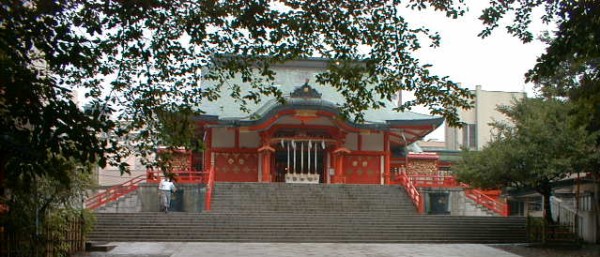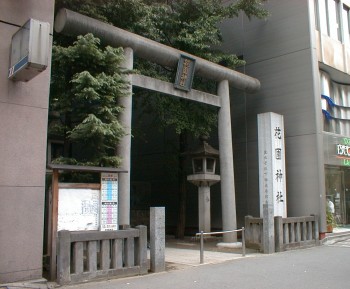
Hanasono
A Famous Shinto Shrine
Hanasono Online (Japanese Only)

Return to The Three Mountains: August 7th, 1998 -
Return to Shinjuku Ward
-
Return to Tokyo


Return to The Three Mountains: August 7th, 1998 -
Return to Shinjuku Ward
-
Return to Tokyo

|
 But it doesn't really matter now; the small phallic shrine was replaced sometime before 1998 with a new sub-shrine, this one sporting statues of kitsune, fox spirits, an animal legendarily well-known for both its supernatural powers and mischeivious nature.
But it doesn't really matter now; the small phallic shrine was replaced sometime before 1998 with a new sub-shrine, this one sporting statues of kitsune, fox spirits, an animal legendarily well-known for both its supernatural powers and mischeivious nature.
 I searched through some Japanese web pages to see what more I could learn about the shrine. It was established long ago, when Shinjuku itself was just a few buildings... mainly a mansion and a hotel ("Shinjuku" roughly means "new hotel"). The land for the shrine, as well as the Gyoen National Garden in another part of Shinjuku, was donated by a man named Kiyoshige Naito, who had held military control of the area for the defense of the capital in Edo (now Tokyo ward of the larger city of Tokyo). The temple's name comes from the original use of the land as a garden; "Hana-sono" simply means "flower garden". Legend has it that Naito was granted land in the area by the Emporer of the time to the amount of whatever a horse could cover in a set period of time... Naito ran his horse to death -- literally -- and gained a huge plot of land, most of which is now modern Shinjuku ward.
I searched through some Japanese web pages to see what more I could learn about the shrine. It was established long ago, when Shinjuku itself was just a few buildings... mainly a mansion and a hotel ("Shinjuku" roughly means "new hotel"). The land for the shrine, as well as the Gyoen National Garden in another part of Shinjuku, was donated by a man named Kiyoshige Naito, who had held military control of the area for the defense of the capital in Edo (now Tokyo ward of the larger city of Tokyo). The temple's name comes from the original use of the land as a garden; "Hana-sono" simply means "flower garden". Legend has it that Naito was granted land in the area by the Emporer of the time to the amount of whatever a horse could cover in a set period of time... Naito ran his horse to death -- literally -- and gained a huge plot of land, most of which is now modern Shinjuku ward.
 The earliest date I can find at the moment is 1624-1644 for the establishment of the shrine. The main shrine is devoted to the Shinto god Inari. As the tale goes, Inari once appeared to some soldiers stationed in the area and guarenteed them that when they needed to have good aim they would have it. The story got around and, soon, gunmen from other areas were visiting the small shrine marking the visit of Inari in the hope it would improve their aim as well... over time the shrine got larger, and more than just soldiers started to attend it, because Inari is a fairly well-known god who helps people in a lot of little ways (such as the fertility shrine mentioned above). Because of this origin, the shrine has been variously named "Inari Jinjya" and "Hanasono Inari Jinjya" in the past; but now it's just Hanasono Jinjya.
The earliest date I can find at the moment is 1624-1644 for the establishment of the shrine. The main shrine is devoted to the Shinto god Inari. As the tale goes, Inari once appeared to some soldiers stationed in the area and guarenteed them that when they needed to have good aim they would have it. The story got around and, soon, gunmen from other areas were visiting the small shrine marking the visit of Inari in the hope it would improve their aim as well... over time the shrine got larger, and more than just soldiers started to attend it, because Inari is a fairly well-known god who helps people in a lot of little ways (such as the fertility shrine mentioned above). Because of this origin, the shrine has been variously named "Inari Jinjya" and "Hanasono Inari Jinjya" in the past; but now it's just Hanasono Jinjya.
 Initially the shrine also included a Buddhist temple, as it was not unusual for the two religions to exist side-by-side that way; but when the "Meiji Restoration" government replaced the old Shogunate government in 1868, the Buddhist temple was removed from the premises. The Meiji government set up Shinto as the new official government religion over the Shogunate's preferred favorite of Buddhism, which is why the shrine and the temple were separated; it was part of dismanteling the old Shogunate's power base. Many other shrine/temple combinations still exist intact in Japan, but they are all much further away from Tokyo and the Meiji government's center.
Initially the shrine also included a Buddhist temple, as it was not unusual for the two religions to exist side-by-side that way; but when the "Meiji Restoration" government replaced the old Shogunate government in 1868, the Buddhist temple was removed from the premises. The Meiji government set up Shinto as the new official government religion over the Shogunate's preferred favorite of Buddhism, which is why the shrine and the temple were separated; it was part of dismanteling the old Shogunate's power base. Many other shrine/temple combinations still exist intact in Japan, but they are all much further away from Tokyo and the Meiji government's center.
 Nowadays, the shrine is hidden in the middle of commercial city area; the most obvious entrance is sandwiched between two office buildings, so you need to keep your eyes open. It's a nice quiet spot in the middle of the hustle and bustle of Shinjuku, and tends to stay pretty quiet unlike some other shrines and temples. If you want to visit at a more active time of year, there are festivals on the grounds for each New Year (generally the first three days of January) and during O-Bon (around August 15 each year).
Nowadays, the shrine is hidden in the middle of commercial city area; the most obvious entrance is sandwiched between two office buildings, so you need to keep your eyes open. It's a nice quiet spot in the middle of the hustle and bustle of Shinjuku, and tends to stay pretty quiet unlike some other shrines and temples. If you want to visit at a more active time of year, there are festivals on the grounds for each New Year (generally the first three days of January) and during O-Bon (around August 15 each year).

|
Hanasono Jinjya
|
Return to The Three Mountains: August 7th, 1998 - Return to Shinjuku Ward - Return to Tokyo

| All illustrations in these pages are copyright (c) Garth Haslam, and shouldn't be used without his permission. To contact him Click Here! |